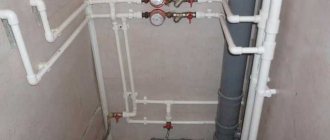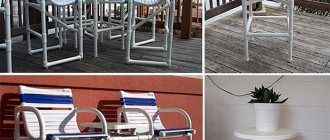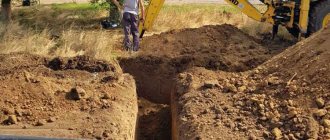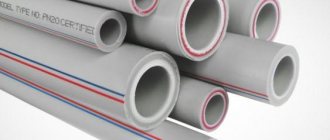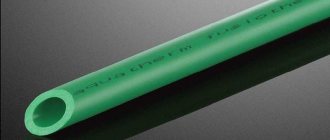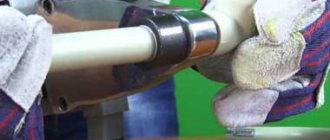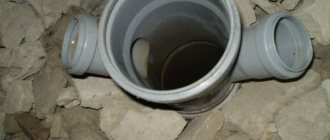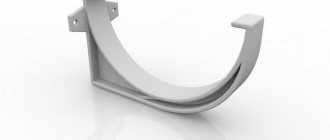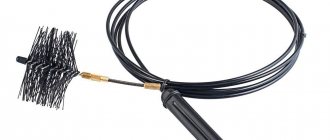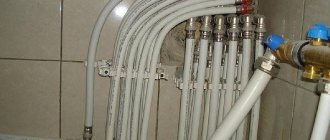Do-it-yourself assembly of metal-plastic pipes
Even at the initial stage of work, you should clearly know the required amount of material and determine for yourself the future design scheme. You can install metal-plastic water pipes yourself, at home, without the involvement of expensive specialists.
Metal-plastic pipes, due to their excellent performance characteristics, are used for many purposes:
- for transporting liquid and gaseous substances;
- for transporting compressed air;
- as a supply of heating components;
- in modern systems “warm floor”;
- when installing air conditioners;
- in irrigation systems;
- in water supply, drainage and heating systems.
However, having a lot of undeniable advantages, it should be remembered that such pipes are not suitable for use in:
- central heating supply system with elevator units;
- rooms with fire safety level “G”;
- hot liquid supply systems of any type with pressure >10 bar;
- places where heat sources with surface temperatures above 150 degrees are located.
Sewage is the most important communication in the house. Naturally, many questions arise about how to install it correctly. Previously, its wiring was carried out with metal components, but they have many disadvantages. Nowadays, plastic pipelines are increasingly being used for this purpose.
Basic installation rules
When installing pipes made of metal-plastic, you need to learn how to properly work with this material and follow the following rules:
- To make a hidden pipeline installation, you should provide space for removable panels (hatches). These hatches will provide access to the compression fittings.
- Installation into the house structure should be done using sleeves whose diameter is 0.5-1 cm larger than the pipe.
- In plumbing and heating systems, the surface of pipes and elements should be monitored - it should not be damaged. This applies even to small defects.
- When unpacking the bay, do not use sharp tools, they can damage the products.
- Markings should be made with a marker or pencil.
- It is recommended to install the entire structure using hangers and supports. They will help attach the structure to the wall and ensure its reliability.
And of course, the main rule is that all work should be done carefully and carefully. The fact is that all elements of the system are very sensitive to various mechanical damage. You should not take on such a responsible job if you do not have the necessary knowledge and experience - you risk ruining the material. In this case, you will not only not save, but also overpay twice.
Operational and physical features of metal-plastic pipes
Plastic pipes have the following features:
- They are environmentally friendly, the share of volatile substances in metal-plastic according to GOST does not exceed 0.035%.
- The material is non-corrosive and chemically neutral.
- Thanks to the smooth inner surface, limescale, rust, and dirt are not deposited on the walls.
- In the manufacture of pipes, polyethylene with a degree of cross-linking of at least 60% is used.
- A distinctive feature of metal plastic is its strictly fixed wall thickness of 2, 3, 4, 5 mm.
- Pipes are produced in coils with a length of 50 to 200 m. Their dimensions, according to GOST, are determined by the outer diameter and consist of the following number series: 16, 18, 20, 26, 32, 40, 50, 60 mm. It is worth noting that this series does not coincide with the standard 16, 20, 25, 32, 40, 50, 63 due to the fact that between standard sizes a fixed wall thickness of 2, 3, 4, 5 mm is maintained.
- Thanks to the aluminum shell, the products are gas-tight, which allows them to be widely used in systems with metal components (connecting boilers, pumping equipment, fittings, wiring of panel radiators).
Rice. 3 Press fittings for metal-plastic pipes
Article on the topic:
What are the types of fittings for metal-plastic pipes, installation features. The article describes options for connecting metal-plastic pipes, types of fittings, an overview of leading manufacturers and installation instructions.
- According to GOST, the service life of metal-plastic pipelines should not fall below 50 years if it is used in cold water supply lines.
- Pipes for water supply transporting hot water or used in heating systems must last at least 25 years.
- Like all polymers, metal-plastic pipes have low thermal conductivity of about 0.43 W/m °C and are capable of absorbing noise.
- Capable of withstanding pressure when used in networks with a cold working fluid up to 25 bar, when working in a hot environment 10 - 12 bar.
- The maximum operating temperature at which metal-plastic products can be operated is 95 °C.
- Thanks to the smooth shiny surface they have an aesthetic appearance.
- Rigid metal-plastic pipes are bent using special pipe benders made of metal spirals.
- The disadvantages of metal-plastics include their poor resistance to ultraviolet radiation.
- During installation, a metal-plastic pipeline, due to its rigidity, can be irreversibly damaged by physical impact on the shell.
- The main disadvantage of all pipe products with aluminum shells is the likelihood of their delamination due to the difference in the thermal linear expansion of aluminum and polyethylene.
Rice. 4 Application of plastic pipes
Three main methods of pipe routing
There are several ways to make wiring for modern types of metal-plastic pipes. When choosing the appropriate option, you should take into account rationality and the possibility of gaining access to the system during further operation.
Read more about metal-plastic pipes in the article - Metal-plastic pipelines
Hidden
With this system, pipes and connections are hidden in the walls under external finishing materials. Only fittings and bends that will be used to connect plumbing are brought to the surface. This method involves installing a water supply system and its entire structure in the walls, where niches for pipes have been prepared in advance. After installation is complete, the surface is sealed.
The hidden system allows you to preserve the interior design, which is important. Also, this installation option will protect the pipes from unwanted damage.
However, this method also has its drawbacks. When laying, you need to groove the surface, and after installing the system, restore everything again. This method is completely unsuitable for load-bearing walls, because their violation is prohibited and is unsafe for the entire structure of the building. We should not forget about the costs associated with additional work.
Open
When it is not possible to hide pipes in the walls, they are laid on the surface. This method is convenient because you can visually monitor the condition of the entire system and its connections, and if a problem arises, you can quickly clean the area or replace individual components.
The pipes are laid along the surface of the walls, which allows you to control the joints and significantly reduce the final cost of the entire work.
This option is suitable for premises in which repairs have already been made, but for some reason the pipes have not been installed. Among the advantages of an open wiring system, ease of installation and lower cost compared to the previous wiring option should be noted.
Combined
Perhaps the combined wiring system is currently the most popular way to install communications. The pipes are laid along the walls, then covered with a box made of plasterboard, tiles or false panels. This method is very difficult, because you need to perfectly calculate how such elements will fit into the interior.
Blitz tips
- You can carry out installation work yourself, the main thing is not to rush, and if you need to perform any action for the first time, for example, bending, then it is better to first practice on some unnecessary piece of material.
- All work must be carried out only when the water supply from the riser is turned off.
- Do not be afraid to use modern materials when carrying out repair work. Plastic used in building materials, if not heated above certain temperatures, does not emit harmful substances. Of course, this is only true for certified products purchased at specialized retail outlets.
Similar articles:
- Do-it-yourself technology for installing polypropylene pipes
- Waterproofing a pool under tiles: joint waterproofing technology, execution technology
- Do-it-yourself restoration of a cast-iron bathtub: enameling with liquid acrylic (video)
- How to make site drainage with your own hands
Wiring diagrams for bathrooms and bathrooms
When construction work is carried out in bathrooms and toilets, three different wiring schemes are used. In private homes, it is best to use a collector.
Efficient collector system
This is a convenient and proven option, which involves connecting all objects to a central pipe using a supply pair. This will allow the tap to make adjustments or completely turn off the water supply for each plumbing fixture individually.
If you use serial wiring, then all devices will have their own shut-off valve. The regulation devices will be placed in one place - the collector; it should be placed in a specially designated place. Supply pipes that have a minimum of connections do not require constant monitoring, and this allows them to be hidden. The disadvantage of such a system is its high cost, because for each connection you will need to buy a special shut-off valve.
This system is very complex and all installation work must be carried out accurately and carefully. The advantage of this system is that if a separate device breaks down, you do not need to completely disconnect the bathroom from the water supply - you just need to turn off the shut-off valve that is responsible for the broken device.
Serial connection system
With a series connection, all plumbing fixtures are connected to the main pipe using a tee. This method is most suitable for bathrooms with not a very large number of points. The advantage is that sequential wiring can be done after the repair is completed if you use an open pipe laying system.
The entire assembly process is quite simple - the pipe is laid from one device to another, and at the same time the supply element is removed from the tee.
Financial costs will be minimal, but it is important to remember that with a large number of points, the water pressure may not be enough.
Wiring system with pass-through sockets
If the choice fell on this wiring system, then the plumbing is connected in the same way as in the series version, however, sockets are installed, not tees. This system is used only in private homes, since it requires large lengths of pipes and the installation of a pump, which must provide the proper water supply pressure.
During connection work, the following nuances should be taken into account:
- minimum number of connections;
- pipes and ferrules must be made of the same material;
- It is advisable to insulate the pipeline to prevent condensation;
- the system should be designed in such a way that there is easy access to meters, filters and plug connections.
Strict adherence to all these rules will help to create a long-term and high-quality system that will serve accurately and properly for many years.
Wiring system with pass-through sockets
The work of installing sewer pipes has a number of its own characteristics. Large-diameter pipes should be installed here and the slope of the pipeline should be provided. For normal and unhindered drainage of water and to prevent blockages, you should remember:
- it is necessary to maintain an inclination towards the drain manifold;
- it is strictly forbidden to make bends at an angle of 90 degrees;
- install special tees with removable covers in front of turns where blockages can form;
- When assembling the system, you need to leave a reserve that will serve during thermal expansion of the products;
- For sewerage, use pipes whose diameter will ensure good passage through them.
Advantages and disadvantages of metal-plastic water supply
There are several objective indicators that allow metal-plastic pipes to outshine their competitors when installing a water supply system in an apartment or house:
- Easy to install. If the work is carried out carefully, it can be performed by anyone without any preparation. In practice, this is something like a construction set, the assembly of which does not require expensive tools or special skills.
- Reliability. The 50-year guarantee is proof of this. But note that this applies to pipes, not their connections.
- Price. One thing can be said: “Cheaper, but for nothing.” Polypropylene pipes can compete in some way in this parameter, but in other respects they lose.
Based on the above, water supply using metal-plastic pipes is reliable, inexpensive, and you can assemble it yourself. Naturally, connecting to the central system is the prerogative of professionals.
Sadly, every barrel of honey also has its own fly in the ointment . In the case of metal-plastic water supply, these are fittings.
A fitting is a device with which you can:
- change direction;
- drown out;
- connect;
- branch.
In our case we are talking about metal-plastic pipes. If the fitting has the same diameter at both ends, then it is straight; and if different, then transitional.
But these are only their varieties according to their intended purpose, but according to the method of fixation, all fittings are divided into crimp and press fittings.
- Compression fittings. Otherwise called ring-shaped, or serviced. In these, fixation is carried out due to the conical shape, internal surface, crimp nut, which, when tightened, compresses the cutting ring. Such connections can be disassembled and require periodic maintenance. Usually once a year, the compression fittings on metal-plastic pipes through which hot water should be checked and, if necessary, tightened slightly. The reason for their weakening is temperature deformation from hot water. For their installation, two gas (adjustable) wrenches are required.
- Press fittings. Or maintenance-free, they are fixed on the pipe by pressing in a special crimp sleeve. The work is carried out using press tongs. They can be manual or electric. The first ones cost from 4 tr., the second ones from 25 tr. The connection turns out to be permanent, but with a guarantee against leaks, regardless of the water temperature. Most often, press fittings are used in connections that will be walled into walls, or with difficult access after repairs.
The reliability and quality of connections depend on the scrupulous execution of instructions. But for the price... Although press fittings are cheaper than crimp fittings, their total cost for installing water supply in an apartment is equal to the cost of metal-plastic pipes.
Layout of sewer pipes
The installation of sewer metal-plastic has its own characteristics. For sewerage installations, it is necessary to use only pipes with a large diameter (for sinks - from 50 mm, for toilets - from 100 mm). It is also important to take the necessary measures in advance to organize the slope of the pipeline.
To ensure that wastewater is drained unimpeded and no blockages occur, a number of requirements must be met when installing the system:
- The slope of the structure must be maintained towards the drain manifold. It is strictly forbidden to install the outlet at a right angle.
- It is necessary to install special tees (revisions) with removable covers in all areas of the structure that are located before the turns. Blockages most often form in these places.
- Leave special viewing windows opposite the inspection if the installation is carried out in a hidden way.
When assembling the system, be sure to leave a reserve. The fact is that the pipe material tends to expand under the influence of temperature changes.
Areas of application in everyday life of metal-plastic pipes
Polyethylene pipes with aluminum reinforcement are used in the following cases:
- To supply water. Plastic water lines are most often installed to provide hot water supply, although it can also be installed in the cold water supply main, where it will last at least 50 years. It is worth noting that due to the relatively low temperatures of no more than 60 °C in hot water supply lines, installed metal-plastic can be used for more than 25 years.
- In domestic radiator heating systems. The supply and return lines to the batteries are laid from plastic. They are placed along the walls or under the floor in a screed.
- In underfloor heating systems. Due to the highest thermal conductivity and flexibility, aluminum-reinforced polyethylene pipes are more effective than other polymer types in underfloor heating circuits. They are laid on a polystyrene foam base in a snail pattern and filled with screed.
Rice. 5 Design and installation of press fittings
How to bend a metal-plastic pipe
An undeniable advantage of metal-plastic is the ability to bend it in the required place. This can help to significantly minimize the number of fittings during installation. The pipes are bent when it is necessary to make a turn to direct the system to the desired location.
There are several ways to bend a pipe. The simplest, but not always reliable, is to bend the pipe yourself, without additional tools - with your hands. However, this option is not always suitable, because without proper skill, products can be damaged. Therefore, you can purchase a special spring that is designed specifically for bending pipes. The spring is inserted directly into the pipe and simply bent. This helps to avoid unnecessary defects. The most important thing is that the spring size is the same as the pipe size.
You can also use a hair dryer. The main thing here is not to overdo it and not to overheat the plastic. When exposed to heat, the pipe will become pliable and bend in one motion.
But still, if you don’t yet have such experience working with metal-plastic, then the best option would be to use a pipe bender - a tool that is specifically designed for this. With its help, you can bend pipes of any diameter and size without problems and unnecessary damage. A pipe bender will help avoid cracks, breaks and other various damages.
How to attach to walls
If the choice fell on open installation, then you should attach metal-plastic pipes to the walls. Plastic clips are perfect for this purpose. They should be selected taking into account the diameter of the pipe itself. There are single and double clips, depending on the purpose of the pipes. It is advisable to install such clips approximately every meter, or even more often, to avoid sagging. Places where pipes bend should be fixed for reliability on both sides. For each clip, a hole is drilled in the wall and dowels or screws are inserted.
Required Tools
Connections of metal-plastic pipes, as mentioned above, can be made using fittings of various types, which are selected for each specific case. To assemble the pipeline, you will need the following tools and accessories:
- special scissors, with which metal-plastic products can be cut into pieces of the required length (in addition, such scissors are used to properly prepare pipes for installation);
- a calibrator, necessary to remove dents from the end of the pipe that form after cutting (the calibrator also functions as a kind of reamer, with the help of which a chamfer is removed from the inside of the cut product);
- open-end and adjustable wrenches;
- tape measure, electric drill and pliers;
- press pliers (such a tool for installing metal-plastic pipes will be required if crimp-type fittings will be used in the work; for installing metal-plastic pipes for water supply with your own hands at home, mainly manual press pliers of the mechanical type are used, and in the professional field preference is given hydraulic tools);
- expander (this tool is used when sliding-type fittings are used when working with metal-plastic pipes).
Specific tool for installation of metal-plastic pipes
Tools and materials for laying pipes
When laying a metal-plastic system with your own hands, without the help of specialists, you will need a minimum number of tools and materials that are sold in construction stores. But you should choose only high-quality products.
Pipeline installation accessories
When carrying out construction work with metal-plastic structures, you will need a very small set of tools:
- scissors that are designed for cutting pipes;
- chamfer and calibrator;
- roulette;
- drill;
- valves;
- fittings and press
for them; - pipe cutter
- pipe bender;
- sliding and ring wrenches
.
What materials will be needed
When laying a pipeline in the house you will need the following materials:
- pipes (coils, measured sections);
- different fittings - with their help, individual sections will be turned into a whole system;
- fastening elements - various clips and clamps, on which the structure will be fixed;
You should stock up on all the tools and materials in advance so that during work you will not be distracted by purchasing missing items, which will significantly slow down the repair process.
Tools for installation of the structure
Despite the fact that the process of installing metal-plastic pipes with your own hands is very simple, you will still need some tools.
You will need special scissors for cutting, springs for bending them, a calibrator for leveling and flaring the cut area, sanding paper for precise removal of burrs at the joint, wrenches or tube cutters, and pliers to facilitate the installation of fittings.
The practice of using these tools is shown in the video posted in the “installation of threaded fittings” section.
Video 2
From the small list above, each element is important for high-quality work, however, when carrying out urgent work of a small volume (if you are careful), it is quite possible to replace the scissors with a hacksaw or a jigsaw, and the calibrator with any tool that can gently flare and clean the edges of the cut.
Pipe line marking
Before starting work on laying a pipeline, you need to know exactly how the pipes will be placed. A diagram should be developed:
Draw lines of pipes on the walls of the room to visualize the entire structure.
You should install as few tees, fittings and crosses as possible, because they will affect the pressure force.
When laying corners, you need to use a pipe bender or corner fittings.
Free access to all connecting parts must be ensured.
The connecting parts should be installed after completing the calculations and markings.
Fittings for metal-plastic systems
When starting to work, the first thing you should do is cut the pipes into sections of the required length. It is important to make cuts only at right angles to avoid defects. When the pipe does become deformed during cutting, it should be leveled with a gauge.
To connect pipes of different categories into a coherent structure, special elements are used - fittings, which differ in type of design, size and methods of fastening. The most common:
- adapters for connecting pipes with different diameters;
- tees;
- corners that change the direction of water flow;
- water sockets;
- crosses.
Installation
Drawing up a pipeline diagram with all control points, fittings and shut-off valves. To simplify installation work, the pipeline route can also be drawn on the walls in actual dimensions.
It is necessary to decide on the method of connecting the pipes.
Crimping method
After cutting onto the calibrated pipes, put on the nut and ring and insert into the fitting until it stops. Then use an adjustable wrench to hold the fitting tightly, and with the other, tighten the nut on the pipe until it stops.
For better fit, you cannot use lubricants and petroleum products, because they will not ensure a tight connection.
Advantages:
- completely removable connection;
- ease of installation;
- absence of leaks in cold water supply networks over a long period of operation;
- long service life;
- the ability to quickly replace individual sections of the pipeline.
Crimping
The pipes are cut to the required length using a pipe cutter. Then they are calibrated and chamfers are cut at the edges.
Next, the edge of the pipe must be inserted all the way into the press fitting (there is a special hole to control the length). The pipe placed on the fitting is inserted into a press (electric and manual) and clamped until a tight connection is formed.
The crimping process takes no more than 60 seconds. Plastic clips can be removed (to give the structures a finished look).
Advantages:
- no need for maintenance;
- with proper installation, no leaks throughout the entire life of the system;
- Possibility of sewing into walls and under drywall;
- low cost of installation work.
After installing the system, you need to check its functionality - fill the system with water. If there are no leaks, the installation can be considered successful.
If cracks occur in the fitting, it must be replaced. In order to tighten a loose fitting connection, you need 2 adjustable wrenches, one of which holds the fitting, and the other tightens the nut until it stops.
Overview of fittings for metal-plastic systems
The process of preparing for installation involves cutting the pipeline into sections of the required length. The cuts must be made strictly at right angles. If the pipe is deformed during the cutting process, alignment with a gauge is applied. Using the same tool, you can also remove the internal chamfer.
After all the pipe elements are ready, they need to be somehow connected to each other. This is where fittings come to the rescue - special connecting elements that come in a variety of types. They differ not only in their design, but also in the methods of fastening. Let's look at the main types of fittings that may be useful to us in our work.
Collet
They consist of a body, a ferrule, a gasket, and have a detachable design. Their undoubted advantage is that such a fitting can be used several times. The thread allows them to be combined with household appliances.
Push-in fittings allow you to connect pipes made of different materials, because such cases occur quite often during repairs. If the pipelines have different diameters, then the thread of the part must correspond to the metal pipe, and all other parts must correspond to the plastic pipe.
Compression
Compression fittings are very often used when working with metal-plastic structures. With their help, you can easily make connections without special tools. To connect, put a nut on the end of the pipeline, then a ferrule ring, insert the shank into the pipe, then put the union nut on the fitting and tighten it. The most convenient way to do this is with two keys - one to fix it, and the other to tighten it.
Push fittings
Very practical elements for connection. Fixing them does not require any special skills or tools. To install the fitting, it must be inserted into the connecting piece, and the other end of the pipeline must be visible through the window. After installation is completed, thanks to the included water flow, the fitting wedge is pushed forward and forms a clamp that will prevent leakage. Push fittings allow you to quickly and efficiently create the required structure, ensuring a durable connection. The only drawback of these fittings is their rather high price per piece.
Press fittings
This type of fittings is used to create strong, sealed connections that will be permanent. They are used only once. At the beginning of installation, the part is calibrated, and then the fez is removed. Then you should put on the sleeve and insert the fitting. The sleeve is held with press jaws
and the part is clamped tightly. Fasteners installed in this simple way are reliable and of good quality (with a warranty period of up to 50 years). Due to their qualities, they are used in hidden wiring.
Installation of metal-plastic pipes using compression fittings
The most common and simple connection for self-installation of water supply from metal-plastic pipes. You will need 2 wrenches for the union nuts. The connection can be easily replaced if necessary. The parts, despite the variety of configurations, are of the same type in design. They consist of a cast body with threads, ferrules for securing the pipe and union nuts. Tightness is ensured by sealing rings.
Using compression fittings, installation of metal-plastic pipes.
Sequence of work:
- Unscrew the fitting and disassemble it. Make sure that the rubber seals are present. Assemble: the nut, then the ring is put on the pipe.
- The calibrator is inserted and the pipe is flared. The inside and the shank of the fitting with the gasket are lubricated with a soap solution. These measures make installation easier and the gaskets do not move or tear.
- The fitting is inserted until it stops, and the ring is moved. Tighten the nut using 2 wrenches.
The last operation requires some skill. If you don't tighten it enough, a leak will occur; if you overdo it, the fragile nut will burst. You should stop the moment you hear a slight crunch. The connection is periodically inspected and the nuts are tightened if a leak occurs.
Connection of plastic and metal pipes
When replacing a plumbing or heating system, it is often necessary to connect old communications made of metal and metal-plastic. Most often, such a connection is made at a branch from the riser.
In such a situation, an old metal pipe is cut at a short distance of 3-5 cm and a thread is cut on it. After this, screw on the fitting with the union nut
(
collet
) or internal thread. Having completed this simple procedure, you can continue to install metal-plastic structures using standard technology.
Preparation for installation
Before installing a water supply system, you must carefully consider its layout and location. First of all, it is worth noting on the plan all points of water consumption (faucets, shower, washing machine and dishwasher), relative to their location in the house.
Video 1
Then you need to connect these points with lines indicating pipes, and you need to note their diameter, the direction of water flow, and also divide them into those intended for hot and cold water. Calculate the approximate footage of the resulting diagram.
It is necessary to buy pipes with a reserve of at least 10 meters, since when installing them yourself, losses during assembly are inevitable. If they still remain, they can always be used during repairs or connecting new equipment.
After this, it is necessary to mark on the diagram all the connection points, as well as those places where the locking devices will be installed.
Safety valves must be installed at the entrance to the house in front of the meter, as well as in front of each consumption device.
See how to install a polypropylene water supply with your own hands.
Having done this, you will find out the number of installation units required to assemble the water supply system and their specifications. An approximate calculation process is shown in the video.
Non-standard connections with metal pipes transition to a different diameter
Installing or replacing a heating, sewer or water supply system often requires the use of ingenuity. For example, when you have to think about how to connect elements of metal pipes with metal-plastic. The task becomes more complicated if the ends of the pipeline that need to be connected also have different diameters. Often this problem arises, for example, in the area where wastewater is drained from the riser. What to do?
The end of the metal pipe must be cut at a certain distance - from 3 to 5 cm. An appropriate thread is cut on the pipe, which will help screw the fitting onto it. A fitting with an internal thread or a collet (cap nut) is suitable here. After this, installation of the pipeline can be carried out using standard technology, which was described above.
It is worth noting that there are special types of fittings that are intended for use in pipeline sections where there is a transition from metal-plastic to metal.
This fitting must be selected in accordance with the diameter of the metal pipe. The adapter must have an internal thread. Connecting in this way requires additional sealing. The joint can be wrapped with flax or greased with a special packaging paste. Or just use fum tape.
To work with pipelines of different diameters, you will also need to select a suitable adapter, only now with a nut fastening.
Connecting pipes from different materials
Beginner home craftsmen who decide to install a pipeline system on their own often have a question about how to connect metal-plastic pipes with pipe products made from other materials (in particular, metal or polypropylene).
Fittings for connecting pipes made of various materials
To solve this problem, combined fittings of various types are needed. Thus, the connection of metal-plastic pipes with metal ones requires the use of products in the design of which both crimp and threaded connections are used. Installation is performed according to the following algorithm.
- Before installing a fitting on a metal pipe, sealing material is wound onto the pre-threaded end of the pipe.
- Then, a metal-plastic pipe, previously prepared according to the standard scheme, is connected to the fitting, the second end of which is made in the form of a fitting, onto which a crimp ring and a union nut are put on.
- Fixation of the connection is ensured by screwing the union nut onto the threaded part of the connecting element body.
Connecting metal-plastic pipes with polypropylene pipes
When creating a water supply system or pipe lines for other purposes, it often becomes necessary to connect polypropylene pipes with metal-plastic. Installation is carried out using special threaded fittings.
Prices for materials and services
The average price for installing a metal-plastic pipeline starts from 3,000 rubles. Naturally, the cost of materials is not included in this amount. The final price is determined depending on the volume and complexity of the work, installation methods and associated costs. A linear meter of metal-polymer pipe with a diameter of 16 mm costs an average of 75 rubles, with a diameter of 26 mm - 185 rubles. The price for fittings is from 109 to 300 rubles.
The right approach to installation and high-quality materials will help create a durable system that will serve for a long time without leaks, repairs and unnecessary financial costs.
Pipe fastening
clips
After the water supply has been assembled, you will need to install it on special clips, which must correspond to the diameter of the pipe of the appropriate size. First of all, the clips are mounted on the wall using screws.
Then the pipe is taken and forcefully inserted into these fasteners. This is the only possible mounting option.
The use of rigid clamps for fixing is strictly prohibited; pipes must be able to slightly change their geometry when the temperature of the liquid that circulates inside changes. Only clips perform this function well.
The water supply cannot be installed only in a straight line. Turns are inevitable when constructing a water supply system.
It is not necessary to purchase a tool called a pipe bender if you only need to change the direction of the water pipe a few times. When using a pipe with a diameter of 16 mm, this is done manually. You just need to follow some rules that apply to all diameters.
The bending radius should not be less than 5 pipe diameters, for example, for a 20 mm pipe, the minimum turning radius is 100 degrees.
If the diameter is more than 16 mm, then in order to correctly bend, you need to use a special steel spring, which can be purchased at almost any building materials store.
The bending is done in this way. The spring is inserted into the pipe cavity and moves towards the bend. If you have to bend at a considerable distance from the edge, then a rope should be tied to the spring. This is required so that after completing the bending procedure the spring can be pulled out of the pipe.
You can also move the spring a considerable distance using a powerful neodymium magnet, which, when in contact with the pipe, must be guided along to the point of bending. When the middle of the spring is aligned with the middle of the intended bend, the pipe should be bent manually. The spring is then pulled out using a rope.
If you need to bend a large-diameter metal-plastic pipe, then to the method indicated above, you need to add 1 more spring, which is put on from the outside and also led to the middle of the bend.
A metal-plastic pipe can be bent using sand or salt. To do this, dry calcined sand or salt is poured into the cavity of the pipeline, then both ends of the pipe are securely closed with plugs, and a bend is made in the right place. After completion of the work, the sand is removed.
Metal-plastic lines are secured to walls and other surfaces using special clips. Such devices make it easier to dismantle metal-plastic pipes with your own hands if necessary.
If the product is deformed, a calibrator will help return it to shape.
Choose clips according to the size and diameter of the pipes.
How to attach: install the clip using dowels and self-tapping screws. To prevent the pipeline from sagging, install fastenings to the wall at a distance of no more than 1 m. When turning or existing bends, the pipeline is fixed on both sides.
You can bend a piece of metal-plastic with your hands, using a spring, a hair dryer or a pipe bender:
- Manually. The product is shaped by manual pressure. Suitable for experienced craftsmen with small pipe diameters.
- The use of a spring prevents deformation (stretching, tearing, uneven bending) and simplifies operation. The device is inserted into a bendable part and can be bent. The spring must correspond to the working diameter.
- The heat of the hairdryer softens the plastic, and the product made from it bends in one movement. The main thing is not to overheat the material.
- A pipe bender will ensure a perfectly even turn. You need to set the bending angle, insert the part into the grooves and bring the handles together.
